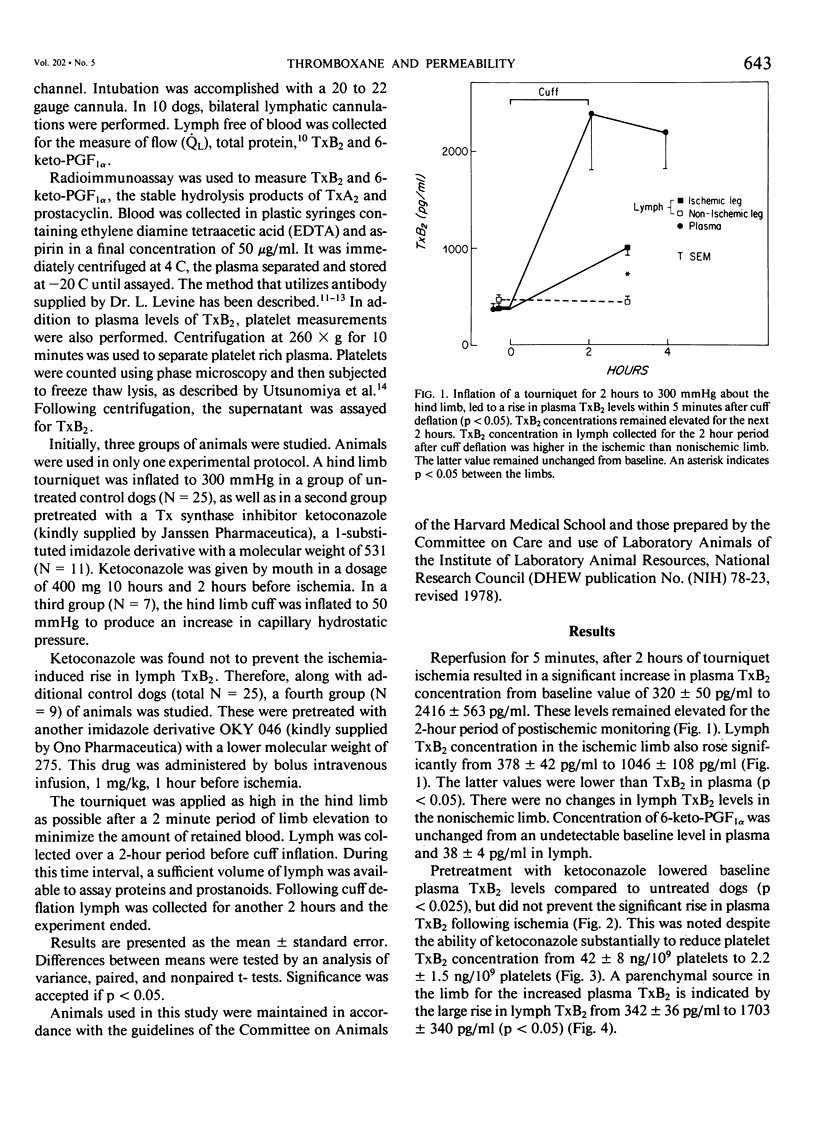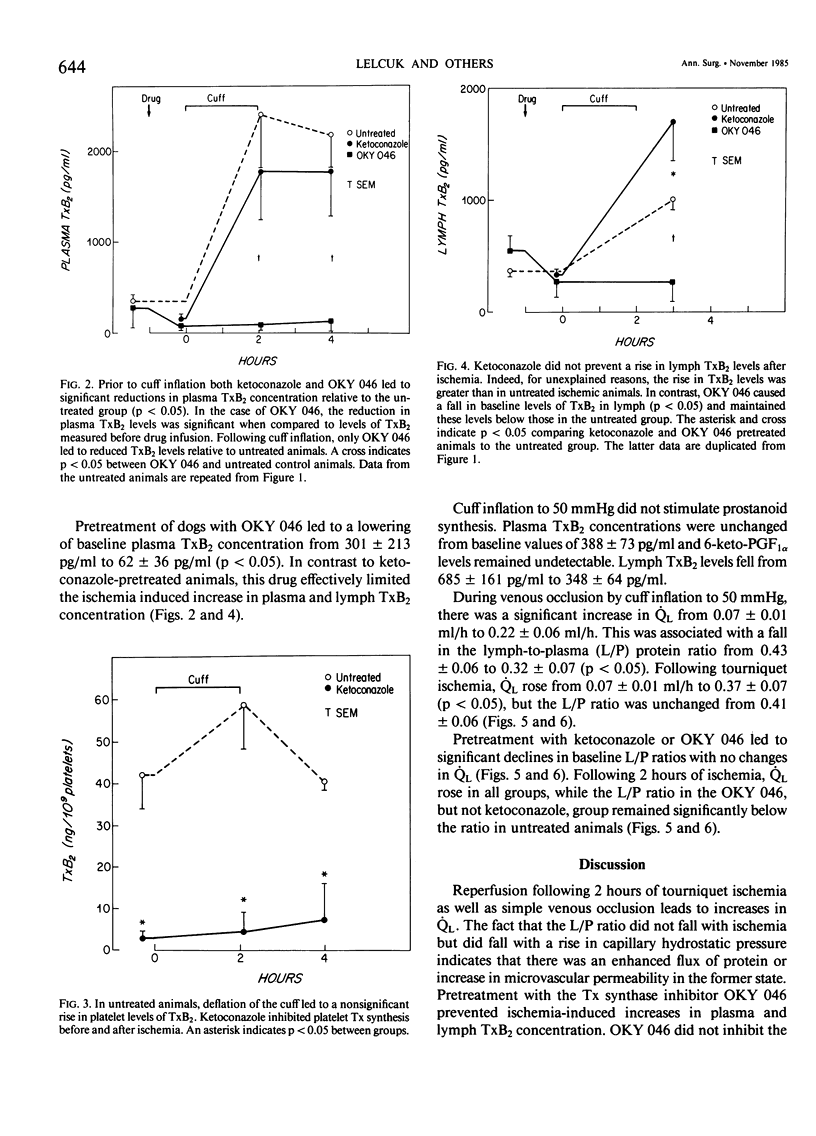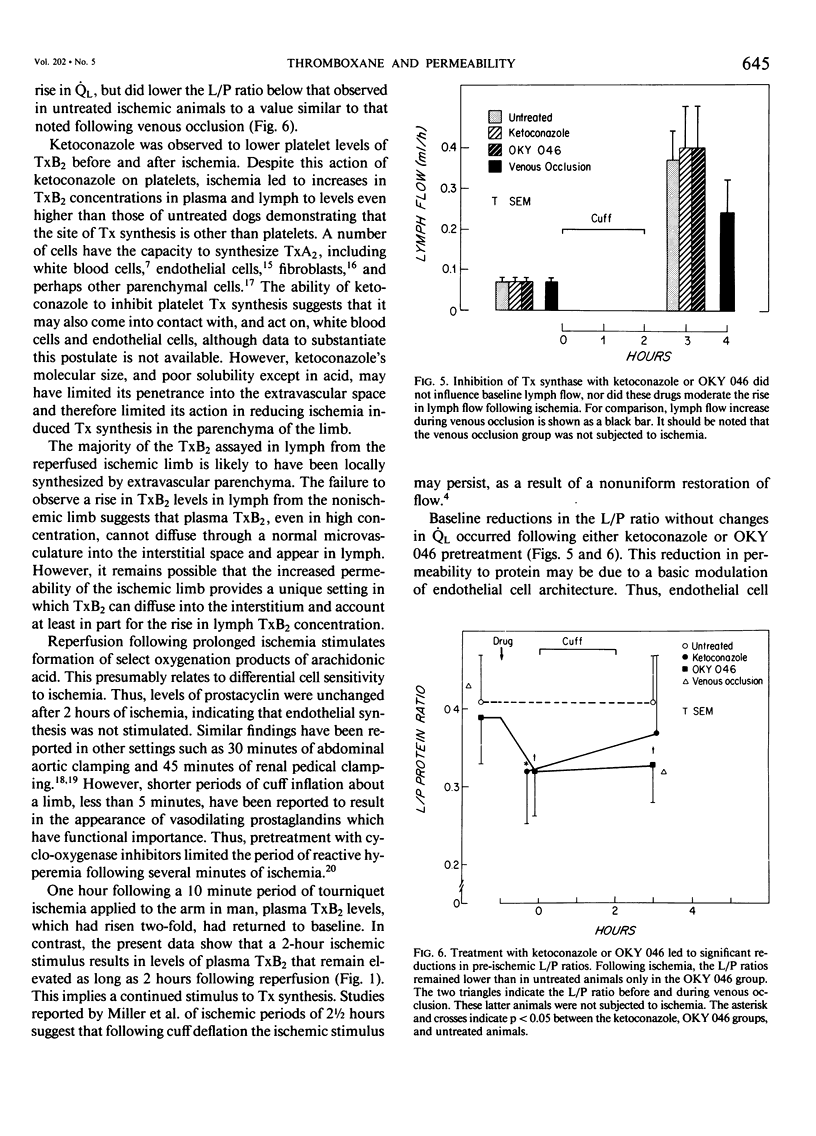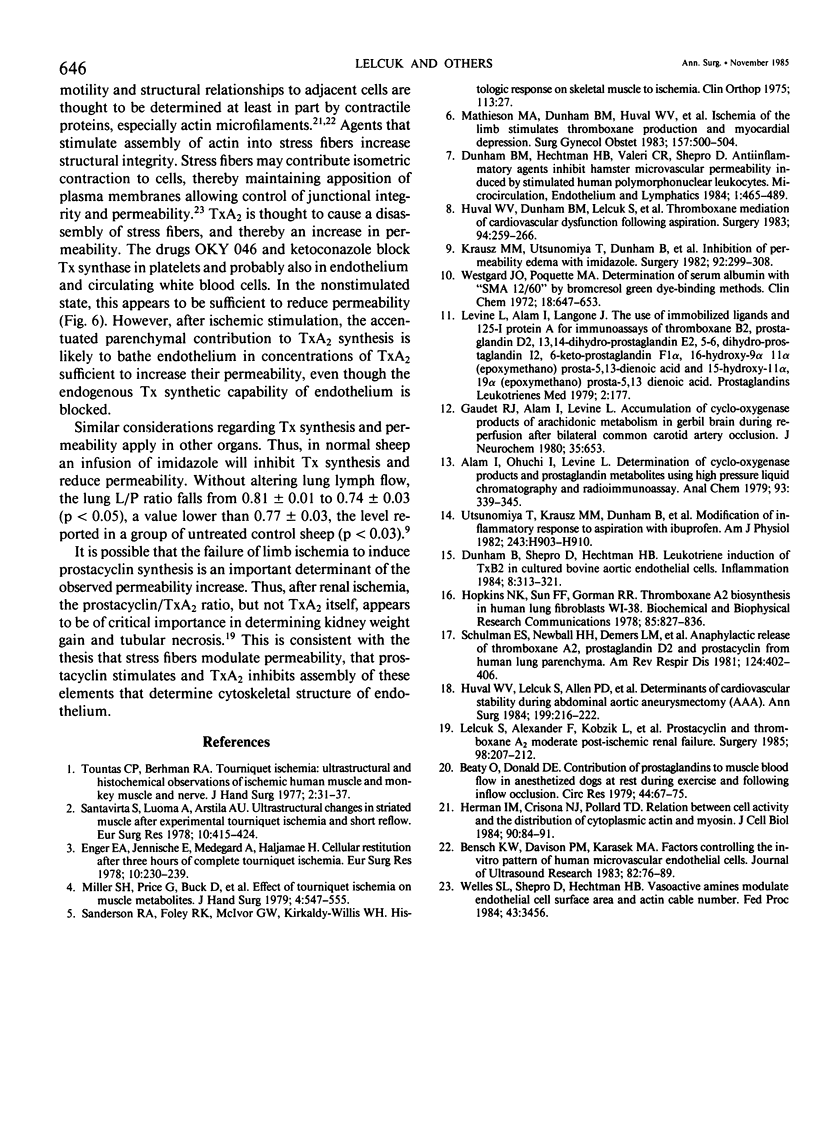Abstract
Reperfusion after limb ischemia results in muscle edema as well as excess secretion of thromboxane A2 (TxA2), an agent associated with permeability increase in other settings. This study tests whether TxA2 moderates the permeability following limb ischemia. A tourniquet inflated to 300 mmHg was applied for 2 hours around the hind limb of four groups of dogs. In untreated animals (N = 25), 2 hours following tourniquet release, plasma TxB2 values rose from 320 pg/ml to 2416 pg/ml (p less than 0.001), and popliteal lymph values rose from 378 pg/ml to 1046 pg/ml (p less than 0.001). Platelet TxB2 was unaltered and plasma 6-keto-PGF1 alpha levels did not vary. Following ischemia, lymph flow (QL) increased from 0.07 to 0.37 ml/h (p less than 0.05), while the lymph/plasma (L/P) protein ratio was unchanged at 0.41. These measurements indicate increased permeability since increase in hydrostatic pressure in a second group by tourniquet inflation to 50 mmHg (N = 7) led to a rise in QL from 0.07 to 0.22 ml/h, but a fall in the L/P ratio to 0.32, a value lower than the ischemic group (p less than 0.05). Pretreatment with the imidazole derivative ketoconazole (N = 11) reduced platelet Tx synthesis from 42 ng to 2 ng/10(9) platelets, but lymph TxB2 levels rose to 1703 pg/ml after ischemia, indicating an extravascular or vessel wall site of synthesis not inhibited by ketoconazole. Pretreatment with a lower molecular weight imidazole derivative OKY 046 (N = 9) inhibited all Tx synthesis after ischemia. Prior to tourniquet inflation, both OKY 046 and ketoconazole lowered plasma TxB2 levels as well as the L/P ratio (p less than 0.05). After ischemia, OKY 046, but not ketoconazole, maintained the L/P ratio at 0.33, a value below that of untreated animals (p less than 0.05). These results indicate that nonplatelet-derived TxA2 modulates both baseline and ischemia-induced increases in microvascular permeability in the dog hind limb.
Full text
PDF




Selected References
These references are in PubMed. This may not be the complete list of references from this article.
- Alam I., Ohuchi K., Levine L. Determination of cyclooxygenase products and prostaglandin metabolites using high-pressure liquid chromatography and radioimmunoassay. Anal Biochem. 1979 Mar;93(2):339–345. doi: 10.1016/s0003-2697(79)80160-8. [DOI] [PubMed] [Google Scholar]
- Beaty O., 3rd, Donald D. E. Contribution of prostaglandins to muscle blood flow in anesthetized dogs at rest, during exercise, and following inflow occlusion. Circ Res. 1979 Jan;44(1):67–75. doi: 10.1161/01.res.44.1.67. [DOI] [PubMed] [Google Scholar]
- Bensch K. G., Davison P. M., Karasek M. A. Factors controlling the in vitro growth pattern of human microvascular endothelial cells. J Ultrastruct Res. 1983 Jan;82(1):76–89. doi: 10.1016/s0022-5320(83)90098-9. [DOI] [PubMed] [Google Scholar]
- Dunham B. M., Hechtman H. B., Valeri C. R., Shepro D. Antiinflammatory agents inhibit microvascular permeability induced by leukotrienes and by stimulated human neutrophils. Microcirc Endothelium Lymphatics. 1984 Aug;1(4):465–489. [PubMed] [Google Scholar]
- Dunham B., Shepro D., Hechtman H. B. Leukotriene induction of TxB2 in cultured bovine aortic endothelial cells. Inflammation. 1984 Sep;8(3):313–321. doi: 10.1007/BF00916419. [DOI] [PubMed] [Google Scholar]
- Enger E. A., Jennische E., Medegård A., Haljamäe H. Cellulr restitution after 3 h of complete tourniquet ischemia. Eur Surg Res. 1978;10(4):230–239. doi: 10.1159/000128012. [DOI] [PubMed] [Google Scholar]
- Gaudet R. J., Alam I., Levine L. Accumulation of cyclooxygenase products of arachidonic acid metabolism in gerbil brain during reperfusion after bilateral common carotid artery occlusion. J Neurochem. 1980 Sep;35(3):653–658. doi: 10.1111/j.1471-4159.1980.tb03704.x. [DOI] [PubMed] [Google Scholar]
- Herman I. M., Crisona N. J., Pollard T. D. Relation between cell activity and the distribution of cytoplasmic actin and myosin. J Cell Biol. 1981 Jul;90(1):84–91. doi: 10.1083/jcb.90.1.84. [DOI] [PMC free article] [PubMed] [Google Scholar]
- Hopkins N. K., Sun F. F., Gorman R. R. Thromboxane A2 biosynthesis in human lung fibroblasts WI-38. Biochem Biophys Res Commun. 1978 Nov 29;85(2):827–836. doi: 10.1016/0006-291x(78)91237-8. [DOI] [PubMed] [Google Scholar]
- Huval W. V., Dunham B. M., Lelcuk S., Valeri C. R., Shepro D., Hechtman H. B. Thromboxane mediation of cardiovascular dysfunction following aspiration. Surgery. 1983 Aug;94(2):259–266. [PubMed] [Google Scholar]
- Huval W. V., Lelcuk S., Allen P. D., Mannick J. A., Shepro D., Hechtman H. B. Determinants of cardiovascular stability during abdominal aortic aneurysmectomy (AAA). Ann Surg. 1984 Feb;199(2):216–222. doi: 10.1097/00000658-198402000-00015. [DOI] [PMC free article] [PubMed] [Google Scholar]
- Krausz M. M., Utsunomiya T., Dunham B., Valeri C. R., Shepro D., Hechtman H. B. Inhibition of permeability edema with imidazole. Surgery. 1982 Aug;92(2):299–308. [PubMed] [Google Scholar]
- Lelcuk S., Alexander F., Kobzik L., Valeri C. R., Shepro D., Hechtman H. B. Prostacyclin and thromboxane A2 moderate postischemic renal failure. Surgery. 1985 Aug;98(2):207–212. [PubMed] [Google Scholar]
- Levine L., Alam I., Langone J. J. The use of immobilized ligands and [125I]protein a for immunoassays of thromboxane B2, prostaglandin D2, 13,14-dihydro-prostaglandin E2, 5,6-dihydro-prostaglandin I2, 6-keto-prostaglandin F1 alpha, 15-hydroxy-9 alpha, 11 alpha(epoxymethano)prosta-5,13-dienoic acid and 15-hydroxy-11 alpha,9 alpha(epoxymethano)prosta-5,13-dienoic acid. Prostaglandins Med. 1979 Mar;2(3):177–189. doi: 10.1016/0161-4630(79)90035-1. [DOI] [PubMed] [Google Scholar]
- Mathieson M. A., Dunham B. M., Huval W. V., Lelcuk S., Stemp L. I., Valeri C. R., Shepro D., Hechtman H. B. Ischemia of the limb stimulates thromboxane production and myocardial depression. Surg Gynecol Obstet. 1983 Dec;157(6):500–504. [PubMed] [Google Scholar]
- Miller S. H., Price G., Buck D., Neeley J., Kennedy T. J., Graham W. P., 3rd, Davis T. S. Effects of tourniquet ischemia and postischemic edema on muscle metabolism. J Hand Surg Am. 1979 Nov;4(6):547–555. doi: 10.1016/s0363-5023(79)80008-8. [DOI] [PubMed] [Google Scholar]
- Sanderson R. A., Foley R. K., McIvor G. W., Kirkaldy-Willis W. H. Histological response on skeletal muscle to ischemia. Clin Orthop Relat Res. 1975 Nov-Dec;(113):27–35. doi: 10.1097/00003086-197511000-00005. [DOI] [PubMed] [Google Scholar]
- Santavirta S., Luoma A., Arstila A. U. Ultrastructural changes in striated muscle after experimental tourniquet ischaemia and short reflow. Eur Surg Res. 1978;10(6):415–424. doi: 10.1159/000128033. [DOI] [PubMed] [Google Scholar]
- Schulman E. S., Newball H. H., Demers L. M., Fitzpatrick F. A., Adkinson N. F., Jr Anaphylactic release of thromboxane A2, prostaglandin D2, and prostacyclin from human lung parenchyma. Am Rev Respir Dis. 1981 Oct;124(4):402–406. doi: 10.1164/arrd.1981.124.4.402. [DOI] [PubMed] [Google Scholar]
- Tountas C. P., Bergman R. A. Tourniquet ischemia: ultrastructural and histochemical observations of ischemic human muscle and of monkey muscle and nerve. J Hand Surg Am. 1977 Jan;2(1):31–37. doi: 10.1016/s0363-5023(77)80007-5. [DOI] [PubMed] [Google Scholar]
- Utsunomiya T., Krausz M. M., Dunham B., Valeri C. R., Levine L., Shepro D., Hechtman H. B. Modification of inflammatory response to aspiration with ibuprofen. Am J Physiol. 1982 Dec;243(6):H903–H910. doi: 10.1152/ajpheart.1982.243.6.H903. [DOI] [PubMed] [Google Scholar]
- Westgard J. O., Poquette M. A. Determination of serum albumin with the "SMA 12-60" by a bromcresol green dye-binding method. Clin Chem. 1972 Jul;18(7):647–653. [PubMed] [Google Scholar]


